Study of The Interference Colors
![]() (Chemistry Experiment Course in Meiwa High School 2024)
(Chemistry Experiment Course in Meiwa High School 2024)
1. Relationship Between Color, Wavelength, and Energy
Light has the property of waves. Different colors of light have different
wavelengths and energy. Human eyes detect differences in wavelength and
energy as differences in color. Light toward the red end of the spectrum has longer wavelengths and lower energy than light
toward the violet end of the spectrum. Infrared light has even longer wavelengths than red;
while ultraviolet has even shorter wavelengths than violet. Wavelength
is described in units of length.
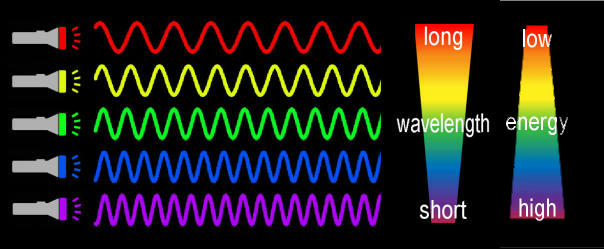

![]() How is the color white made?
How is the color white made?
@@@@¨ LINK ` Even though white light... (Japanese)
![]() What is the wave-particle duality of light ?
What is the wave-particle duality of light ? 
2. What are the interference colors ?
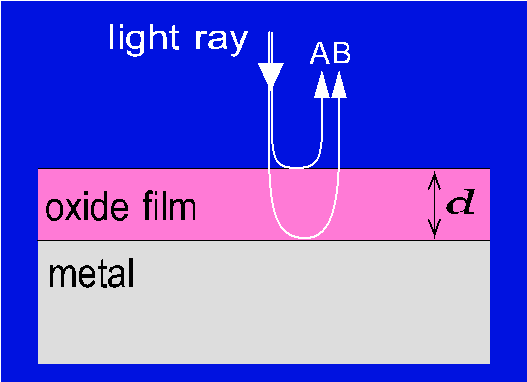
When a light ray falls on the metal surface which an oxide film formed
on, the light ray is divided into two rays, A and B.
Ray A is reflected at the surface of the oxide film, and ray B is reflected
at the metal surface under the oxide film.
Ray B travels an extra distance '2d' before the waves recombine at the surface of the oxide film.
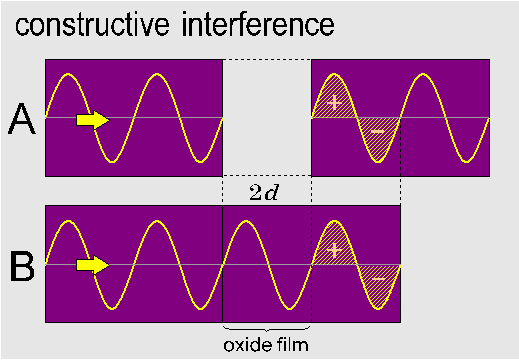 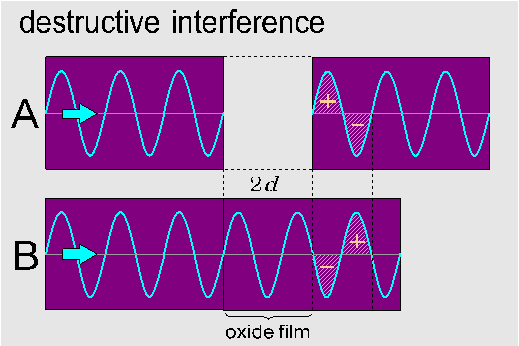 |
||
These two light waves recombined are affected by constructive interference
or a destructive interference depending on the difference in wavelength.
The differences of wavelengths appear as the differences of colors. That's
the reason why an oxide film shows various colors.
It is the same reason that soap bubbles show various interference
colors.
![]() Are there any other familiar examples of interference colors?
Are there any other familiar examples of interference colors?
3. Interference color of oil film (Experiment)
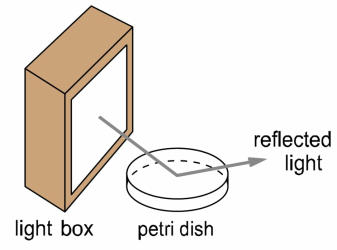 |
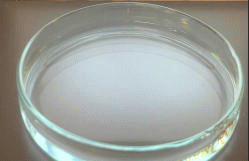 |
 |
| Experiment movie | On the road after the rain |
![]() Procedure of oil film experiment
Procedure of oil film experiment
(1) Pour water into a petri dish.
(2) Shine light from the side with a light box.
(3) Put a tiny drop of chainsaw oil on the tip of a toothpick.
(4) Drop the oil from the tip of the toothpick onto the water's surface.
(5) You can see interference colors.
![]() What factors of oil do you think cause the various colors?
What factors of oil do you think cause the various colors?
4. Simulation of interference colors using Excel
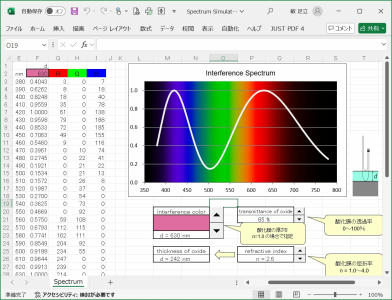 |
@ as shown below. |
|
| |
||
@@@  |
5. Oxide film formed by heating
When a metal is heated in the air, the surface is oxidized by oxygen,
then an oxide film is formed. The oxide film shows various colors. However,
in this method, it is difficult to regulate the thickness of the film,
therefore the interference colors don't become uniform.
(1) Case Of Sn-Zn Alloys
Oxidized surfaces of alloys show various colors based on their thickness.
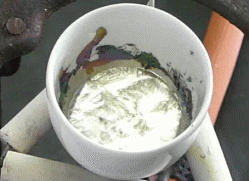

(2) Case Of Stainless Steel
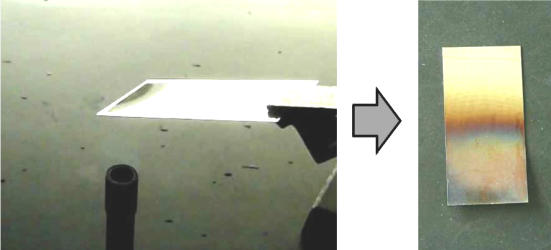

![]() Procedure of heating experiment
Procedure of heating experiment
(1) Sandwich the stainless steel plate with crucible scissors.
(2) Light the gas burner and adjust the flame.
(3) Place a stainless steel plate into the flame and heat it.
![]() Where is the oxide film thick on the plate?
Where is the oxide film thick on the plate?
6. Diffraction grating
@![]() What is diffraction ?@¨ LINK ` @Diffraction (Japanese)
What is diffraction ?@¨ LINK ` @Diffraction (Japanese)
A diffraction grating is an optical element that splits light consisting of many different wavelengths into light components for each wavelength. It has many parallel slits at equal intervals.
.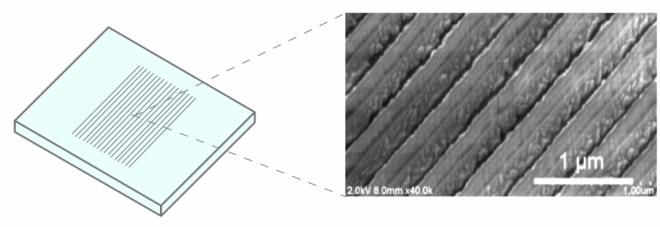
The light that passes through a diffraction grating includes not only light
that travels straight, but also light that travels through diffraction.
The light that has been diffracted (bent) has just a little different optical path length. As a result, areas of constructive interference and areas of destructive
interference made, which can see as brightness and darkness of light.

![]() Experiment of diffraction
Experiment of diffraction

![]() What happens when you change the color of laser light?
What happens when you change the color of laser light?
7. Formation of interference film by anodizing
(1) Electrolysis ` Case of copper chloride iCuCl2)

On the anode (+), chloride ions (Cl-) are oxidized into chlorine gas (Cl2). The anode is the place of the oxidation reaction.
(2) Anodize
If the oxide film is hard to dissolve in water, we can make the oxide film by anodizing method. Using electrolysis, an oxidation reaction occurs at the anode. Anodizing is the oxidation method using electrolysis.@Titanium is especially suitable for anodizing.

‘ Procedure
@(1) Cut a titanium plate into 2~5cm.
@(2) Prepare 3% oxalic acid (COOH)2 solution to use as electrolysis liquid.
@(3) Set a carbon plate for cathode and titanium plate for anode, then start the electrolysis.
@(4) The voltage applied to this circuit should be around 140V at maximum.

![]() How can we make colorful titanium spoons like the one below ?
How can we make colorful titanium spoons like the one below ?
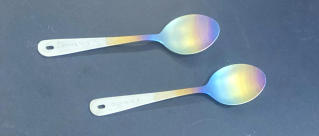
8. Let's try anodizing titanium

![]() How to make patterns?
How to make patterns?
@@@@¨ LINK ` Masking procedure (Japanese)
‘ About power supply
There are three types of DC power supplies that can be easily prepared.
| (1) stabilized power supply | (2) variac@{@self-made @@(slidac)@@ @rectifie |
(3) self-made { self-made @@ variac@@@@@rectifier |
|
@@ 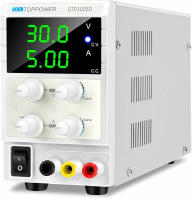 |
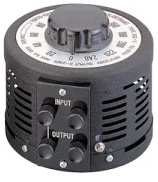 { {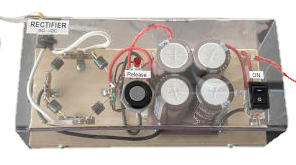 |
 |
|
| Easy to prepare ’ High voltage not available |
Relatively easy, Wide voltage range ’ Requires some level of expertise |
Easy to carry, Low cost ’ Requires technical skills |
![]() Related topics
Related topics
@@@¨ LINK ` About rectifier making (Japanese)
9. Today's Review
‘Discussion‘RESEARCH
![]() What is the wave-particle duality of light ?
What is the wave-particle duality of light ?
![]() What is diffraction ?
What is diffraction ?
![]() Related topics (LINK)
Related topics (LINK)